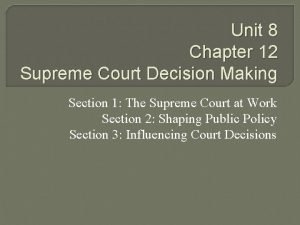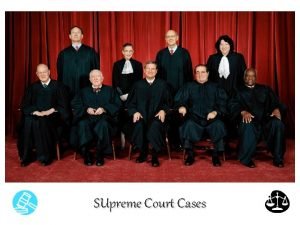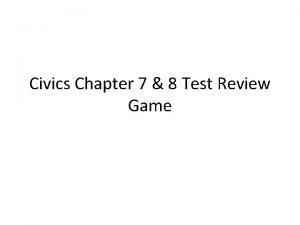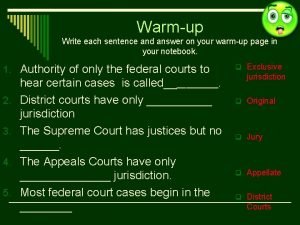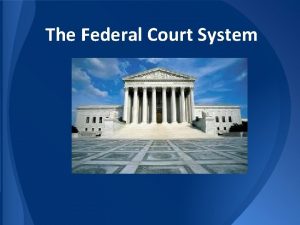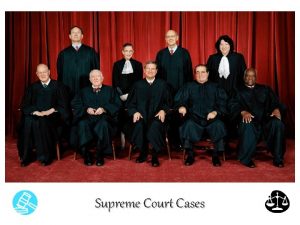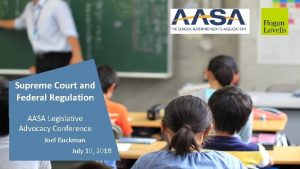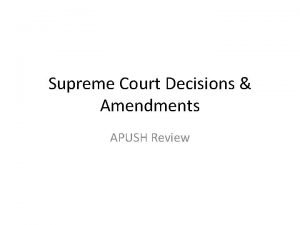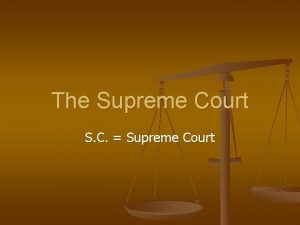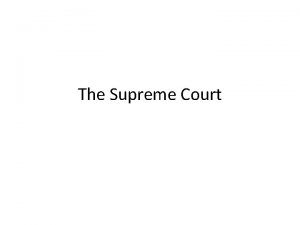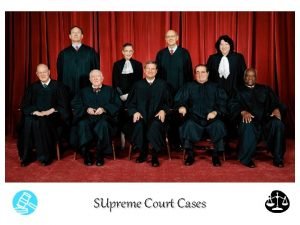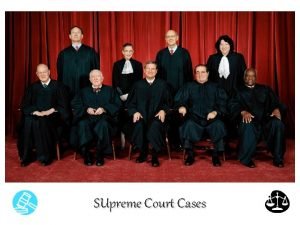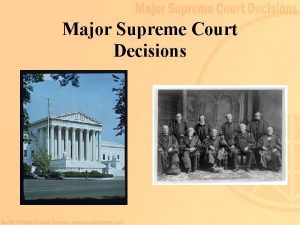THE SUPREME COURT AT WORK THE SUPREME COURT










- Slides: 10

THE SUPREME COURT AT WORK

THE SUPREME COURT AT WORK • When is the Supreme Court in session? • Term of the Supreme Court begins on the first Monday in Oct. and generally lasts until June or July of the following year

JUDICIAL PHILOSOPHY • What role should the Supreme Court play? What should be their guiding principle? • Judicial Activism • The court should play a more active role in creating national policies and answering questions of conflict in society • Judicial Restraint • The court should operate strictly within the limits of the Constitution and only answer questions if a clear violation of the Constitution is present. Policy making should be left up to the executive and legislative branches.

THE SUPREME COURT AT WORK • How does the Supreme Court accept a case to review? • Thousands of cases are appealed to the Supreme Court every yearonly a few hundred are actually heard • Most cases denied because • Justices agree with the lower court decision • Justices believe the case does not involve a significant point of law • Cases that are accepted must meet the rule of four • Four of the nine justices must agree to hear the case • Many of the cases accepted may be returned to the lower court for reconsideration because of a related case which was recently decided

BRIEFS AND ORAL ARGUMENTS • Once a case reaches the Supreme Court, lawyers for each party file a written brief • A detailed statement of the facts of the case supporting a particular position by presenting arguments based on relevant facts and citations from previous cases • Oral arguments allow both sides to present their positions to the justices during a 30 minute period • Justices may interrupt lawyers during this time, raising questions or challenging points of law

JUSTICES VOTE ON THE CASE • After hearing the arguments they individually decide what their opinion is. • The justices meet to cast their votes on the case. • This creates a majority and a minority • Since there is an odd number of justices there cannot be a tie

WRITING OPINIONS • Supreme Court decisions are explained in a written statement called “an opinion” • 3 Types of Opinions: • Majority Opinion – opinion agreed upon by a majority of the justices • Concurring Opinion – written by a justice or justices who agree with the majority opinion, but not with the reasoning behind the decision • Dissenting Opinion – written by a justices or justices who disagree with the majority opinion • Majority opinion become precedents • Standards or guides to be followed in deciding similar cases in the future

SUPREME COURTS IN THE 20 TH CENTURY Warren Court (1953 -1969) • Led by Chief Justice Earl Warren • Often said to be the “most liberal court ever” • Important cases decided • Brown v. Board of Education (1954) – ended segregation in public schools • Gideon v. Wainwright (1963) – states required to provide attorneys for those accused of a crime • Miranda v. Arizona (1966) – police have to inform anyone questioned of their rights in order to use the information in court

SUPREME COURTS IN THE 20 TH CENTURY Burger Court (1969 -1986) • Led by Chief Justice Warren Burger • Returned the Supreme Court to a more conservative ideology • Appointed by Richard Nixon • Important cases decided: • Roe v. Wade (1973) – declared abortions legal with special time constraints • U. S. v. Nixon (1974) – ruled that President Nixon’s private recordings were not protected under presidential privilege and ordered them be turned over to the house investigators

SUPREME COURTS IN THE 20 TH CENTURY Rehnquist Court (1986 -2005) • Led by Chief Justice William Rehnquist • Conservative court that continued to limit, but not reverse, decisions of earlier more liberal courts in the areas of defendant’s rights, abortion, and affirmative action • Important cases decided: • Planned Parenthood v. Casey (1992) – upheld and ruled constitutional a law requiring a minor to wait 24 hours after receiving parental approval before getting an abortion • Roper v. Simmons (2004) –declared that the death penalty was unconstitutional for anyone under the age of 18.
 Is there a basketball court above the supreme court
Is there a basketball court above the supreme court Vocabulary activity 12 supreme court decision making
Vocabulary activity 12 supreme court decision making Insular cases apush
Insular cases apush The u.s. supreme court works chiefly as a(n)
The u.s. supreme court works chiefly as a(n) How cases reach the supreme court worksheet answers
How cases reach the supreme court worksheet answers The supreme court
The supreme court Us circuit court map
Us circuit court map Which of these best summarizes the monroe doctrine?
Which of these best summarizes the monroe doctrine? Cohens vs virginia apush
Cohens vs virginia apush Supreme court does
Supreme court does Apush supreme court cases
Apush supreme court cases

